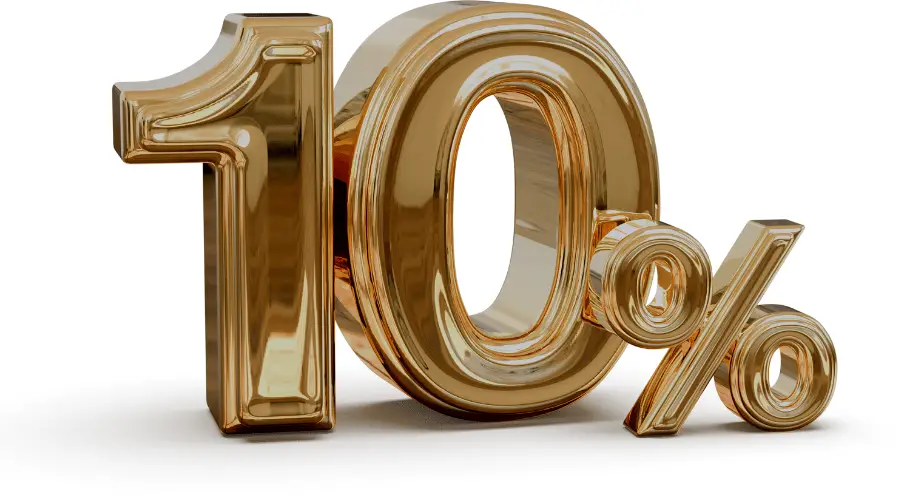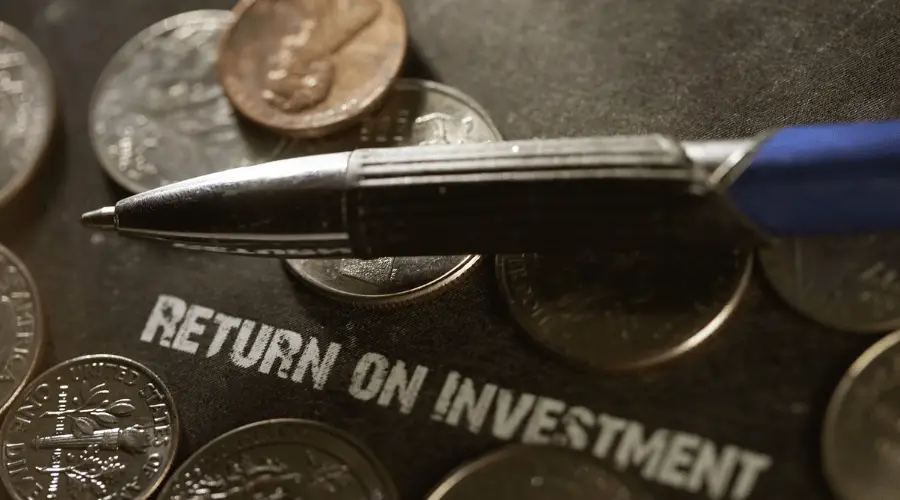10% may seem like a small percentage, but many investors will tell you that this is a very good investment return, with many professional investors failing to meet this benchmark with any sort of consistency.
10% is a good annual return on investment. Very few asset classes, whether that be stocks, bonds or property, can reliably produce 10% yearly returns over time. Achieving a 10% annual return rate allows your invested money to compound over time to significant amounts and therefore build wealth.
So if you’re an investor who is wondering what exactly constitutes a good return on the money you’ve invested into assets, have a read of the below post (estimated reading time is 10 minutes).
is 10% a good investment return?
When it comes to investing your money, 10% is generally considered a good return on investment (ROI). Whilst 10% may not sound like much, most investors find it very difficult to achieve 10% yearly returns over a long time period in typical investments like stocks, bonds or property.
To truly understand why 10% investment returns are actually quite good, we have to consider the impact of compounding. This basically means how your money is able to grow year after year as the returns from the 1st year are able to produce returns of their own in the years to come.
Take the following example whereby you invest £100 and it returns you precisely 10% a year.
Year 1: £100
Year 2: £110 (£100*1.1)
Year 3: 121 (£110*1.1)
Year 4: £133.10 (£121*1.1)
Year 5: £146.41 (£133.10*1.1)
As you can see, the money grows each year without investing anything more than the initial £100 but the reason compounding is so effective is the increase gets bigger each year. In year 2, our investment increased by £10 (£110 minus £100) but in year 3 our investment increased by £11 (£121 minus £110).
If I were to carry the above example on, by year 50, our initial £100 would be worth £10,671.90. After 100 years of compounding, it would be worth £1,252,782.94 which goes to show how significant compounding can be over the long term.
After 101 years, it would be worth £1,378,061.23 which is a £125k jump in just a year between the 100th and 101st years.
Imagine how powerful this would all be over time if instead of investing £100 just once, you did every single month during that period.

What is ‘return on investment’?
Return on investment (ROI) is usually expressed as a percentage which shows how much money your initial investment was able to return over a period of time. If you invested £100 and it grew to £120 after a year, your return on investment would be 20% i.e. £20 increase / £100 investment = 20%.
This metric is very important when it comes to investing or owning a business as in each case, it’s crucial to know how much profit your invested money will make you. Because of this, this metric is very helpful for decision-making.
If, for example, you had two investment opportunities but only had enough free money to take up one of the opportunities, you may try and compare the likely return on investments of both opportunities to see which one is a better use of your money.
Similarly, return on investment is a key metric when it comes to measuring performance. Let’s say you invested £1,000 with a stock broker and at the end of the year, your investments were worth £1,300, that would be a 30% return on investment (£300 profit divided by £1,000 initial investment).
This 30% return could then be compared to how other stock brokers performed or to a relevant benchmark. Whilst 30% may sound like a great return, if every other stock broker returned 50% that year, it’s a poor return relatively speaking.
What is a good return on investment in the UK?
5-10% is a good return on investment for those living in the UK depending on the level of risk each individual is willing to take with their invested money. Generally speaking, the higher the risk, the higher the expected return to compensate the investor for taking on more risk.
Investing in assets outside of the UK is possible even if you live inside the UK. As an example, have a read of the below-linked post which goes into detail on how to invest in the S&P500 (an index of purely American stocks) if you’re living in the UK.
It’s also important to consider inflation here. If your annual investment returns are 10% but inflation is also 10% a year, your real return is 0.
Inflation is basically the eroding of the value of your money. If for example, £5 could buy you five bottles of coke previously, but now £5 could only buy you 4 bottles of coke, the purchasing power of your money has decreased as the same amount of money can buy less.
So if you made 10% on your investments, but inflation went up 10%, you would have more money but it would be worth less relative to the goods and services you want to spend it on.
‘Real return’ means the return on investment percentage less the impact of inflation for the period. I.e. if our return was 10%, but inflation was 4% for the period, the real return would be 6%.
For this reason, it’s important to assess your return on investment of investments with the current level of inflation considered. A 5% ‘real return’ is pretty good and is far better than leaving your money in a low-interest cash account.
What is a good return on investment for stocks and shares?
Anything above an average annual real return of 5% can be considered good for stocks and shares investments. Due to the nature of the stock market, some years will involve significant increases of far more than 5% while other years may result in a loss, but averaged out over time, a 5% return after inflation can be considered a good result for most people.
The S&P 500 (which is an index of the 500 largest stocks in the US) has historically averaged a return of 9.8%. Many investment professionals will use the S&P500 as a benchmark for their investments. The reality is that whilst some investors are able to beat the index through smart investing, the majority fail to do so over the long term.
So whilst all of the above is true, it’s also possible to lose money in an index fund of stocks and shares over time. For more on this, click the below link to the post I’ve recently written on the subject.
Can you lose money in an index fund?
What is the safest way to earn a 10% return on investment?
The safest way to average a 10% return on investment is through the stock market. However, due to the nature of investing, achieving high returns on investment is inherently risky as the market rewards those willing to take on extra risk with the possibility (not guarantee) of higher returns.
How can I get a return on investment above 10%?
It’s difficult to achieve a return of investment above 10% on traditional asset classes like stocks, bonds and property. However, many people start their own businesses and are able to achieve returns far in excess of 10% of the initial money they invested into the venture.
For example, if you invested £1,000 into publishing an Ebook online and you sold 150 copies of that book for £10m each, your return on investment would be 50%. 150 books * £10 per book is £1,500. £1,500 minus the initial investment of £1,000 is £500 profit.
£500 profit divided by £1,000 initial investment = 50% return on investment.
Hopefully, this example illustrates how investing money into your own business or venture can yield ROIs far in excess of what is generally possible with traditional asset classes.
However, as noted above, the higher the expected returns, the higher the risk and starting your own business is not without its risks. We’ve all seen the statistics around how many new businesses fail.

Will a 10% return on investment make me rich?
10% returns on investment won’t make you rich in the short term unless you are investing an already large amount, however, due to the power of compounding, annual 10% returns can make you rich over a long time period provided the 10% returns are after inflation has been factored in.
If you invest £1,000,000 pounds into a stock with 10% yearly returns, your investment will return you £100,000 per year which is clearly a significant return. However, given you had £1 million to invest in the first place, it’s likely you were relatively rich in the first place.
If, on the other hand, you invest £100 a month into the stock market, this won’t make you rich anytime soon but after say 20, 30 or 40 years of compounding, this is likely to be a significant amount and may be enough for you to consider yourself ‘rich’ which is defined differently by each person you ask.
Is a 10% return on investment realistic?
A 10% investment return is generally considered a good return on investment, especially if inflation has been factored in. Whilst not ‘easy’ to achieve, this is a realistic investment return target given the S&P500 index has returned 9.8% on average over its history.
The truth is, most people will struggle to consistently achieve a 10% return on investment (expressed after inflation) over the long term. It’s very plausible that people will be able to achieve an absolute return of 10% a year before inflation is considered.
As always, please remember I am an Accountant, but not your Accountant. In this post (and all of my others) I share information and often give anecdotes about what has worked well for me. However, I do not know your financial situation and do not offer individual financial advice. If you are unsure of a particular financial subject, please hire a qualified financial advisor to guide you.
This article has been written by Luke Girling, ACA – a qualified Accountant and personal finance enthusiast in the UK. Please visit my ‘About‘ page for more information. To verify my ACA credentials – please search for my name at the ICAEW member finder. To get in touch with questions or ideas for future posts, please comment below or contact me here.
